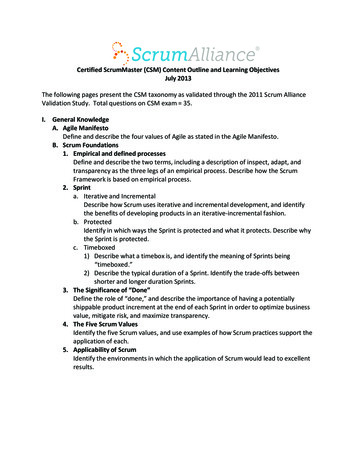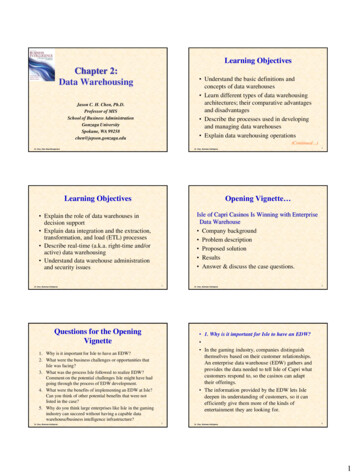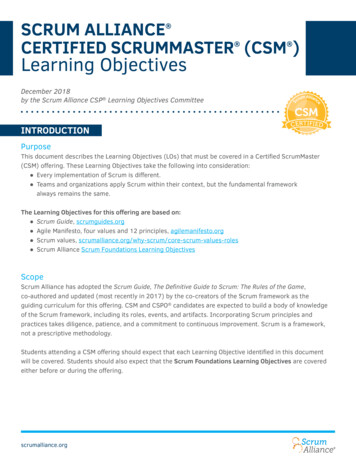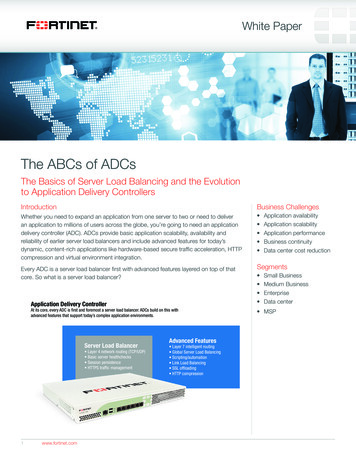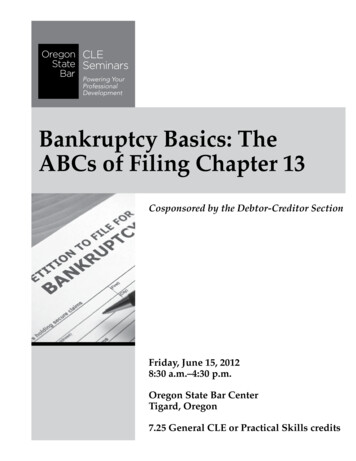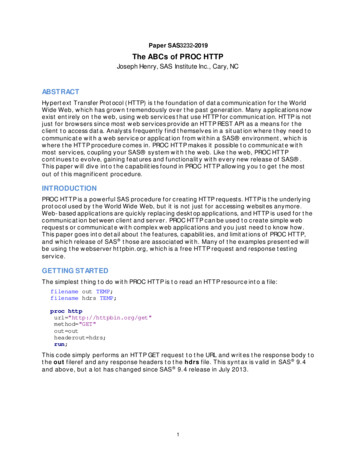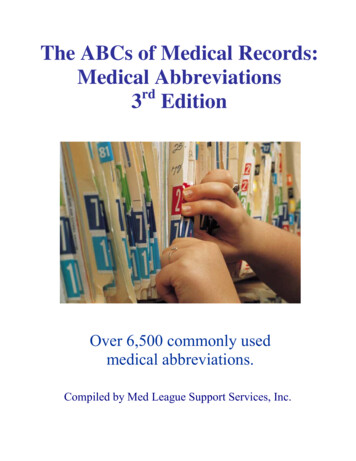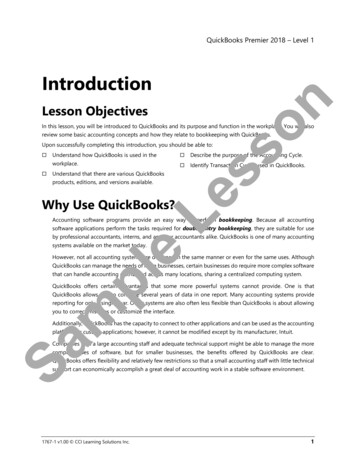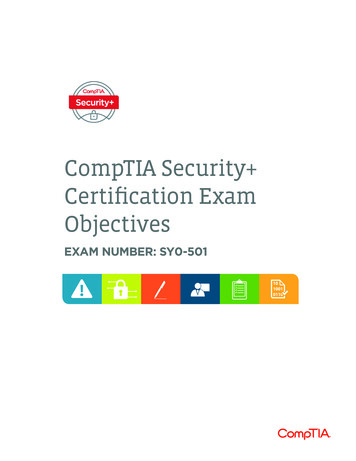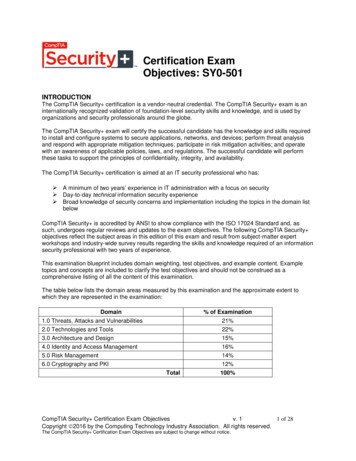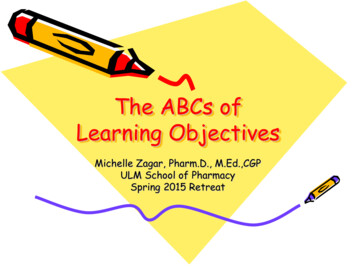
Transcription
The ABCs ofLearning ObjectivesMichelle Zagar, Pharm.D., M.Ed.,CGPULM School of PharmacySpring 2015 Retreat
Our Learning ObjectivesAt the conclusion of this presentation, facultyshould be able to: Distinguish between goals & objectives. Recognize the characteristics of usefullearning objectives. List the 4 components of learning objectives. Identify observable, measurable verbs forwriting objectives in the cognitive domain.
Background Activities required for successful instruction1.Analysis Consider what students already know Consider what students need to know2.Design & development Clearly specify what you intend to accomplish by instruction Select & design learning experiences3.4.ImplementationEvaluation & improvement Assessment of student Assessment of lesson / instructorMager, RF. Preparing instructional objectives. 3rd ed. Atlanta, GA: The Center for Effective Performance; 1997.
Objectives 1962: Robert Mager’s PreparingInstructional Objectives Learning Objective:– “a description of a performance you want learnersto be able to exhibit before you consider themcompetent” p.5Mager, RF. Preparing instructional objectives. 3rd ed. Atlanta, GA: The Center for Effective Performance; 1997.
Why should we writeobjectives?1. Needed to select & design appropriatematerials, content, & methods2. Provides evidence of objectiveaccomplishment3. Helps students organize study towardaccomplishment of objectivesMager, RF. Preparing instructional objectives. 3rd ed. Atlanta, GA: The Center for Effective Performance; 1997.
Goals vs Objectives Goals broad, general, non-specific Overall learning– SoP goal: Promote wellness and disease prevention. Objectives specific, observable, measurable Specific learning– In-class objective: Identify patient characteristics forwhich diabetes screening should be recommended.
Considerations inObjective Writing1. Related to intended outcomes, notprocess for achieving outcomes2. Concerned with students, notteachers3. Specific & measurable, not broad &intangibleMager, RF. Preparing instructional objectives. 3rd ed. Atlanta, GA: The Center for Effective Performance; 1997.
Outcomes vs. Process Teaching & lecturing part ofinstructional process, not the purpose– To provide a lecture on antihypertensives.Mager, RF. Preparing instructional objectives. 3rd ed. Atlanta, GA: The Center for Effective Performance; 1997.
Outcomes vs. Process Teaching & lecturing part ofinstructional process, not the purpose– Explain the basic pharmacology of ACEinhibitors.Mager, RF. Preparing instructional objectives. 3rd ed. Atlanta, GA: The Center for Effective Performance; 1997.
Specific vs. General If objectives aren’t specific enough,can’t determine if they have been met– Discuss Medicare Part D.Mager, RF. Preparing instructional objectives. 3rd ed. Atlanta, GA: The Center for Effective Performance; 1997.
Specific vs. General If objectives aren’t specific enough, can’tdetermine if they have been met Outline the 5 phases of Medicare Part Dbenefits related to cost structure. Describe standard and low-income provisionsof Medicare Part D. Differentiate drugs that are categoricallycovered and excluded by Medicare Part D.Mager, RF. Preparing instructional objectives. 3rd ed. Atlanta, GA: The Center for Effective Performance; 1997.
Students vs. Instructors LEARNING objectives should describestudent's performance, not instructor's Ask “Who are my students & what should theybe able to do at the end of MY instruction inTHIS course?”– P1 vs P2 vs P3 vs P4 vs PGY1 vs PGY2 vsPhD vs BCPSMager, RF. Preparing instructional objectives. 3rd ed. Atlanta, GA: The Center for Effective Performance; 1997.
Students vs. Instructors LEARNING objectives should describestudent's performance, not instructor's Ask “Who are my students & what should theybe able to do at the end of MY instruction?”– Outline the 5 phases of Medicare Part D benefitsrelated to cost structure. (P2 - 4077)– Using the Medicare Plan Finder, justify the mostappropriate stand-alone prescription drug plan for agiven drug list. (P2 - 4099)Mager, RF. Preparing instructional objectives. 3rd ed. Atlanta, GA: The Center for Effective Performance; 1997.
Students vs. Instructors LEARNING objectives should describestudent's performance, not instructor's Ask “Who are my students & what should theybe able to do at the end of MY instruction?”– Given a patient’s list of medications and using theMedicare Plan Finder, provide Medicareprescription drug plan selection counseling andenrollment assistance. (P4)Mager, RF. Preparing instructional objectives. 3rd ed. Atlanta, GA: The Center for Effective Performance; 1997.
Measurable vs.Unmeasurable Describe outcomes that can beobserved– Understand the physiology of aging.Mager, RF. Preparing instructional objectives. 3rd ed. Atlanta, GA: The Center for Effective Performance; 1997.
Measurable vs.Unmeasurable Describe outcomes that can beobserved– Identify age-related changes in pharmacodynamicsensitivity to medications.Mager, RF. Preparing instructional objectives. 3rd ed. Atlanta, GA: The Center for Effective Performance; 1997.
Components ofObjectives A AudienceB BehaviorC ConditionD Degree*Mager, RF. Preparing instructional objectives. 3rd ed. Atlanta, GA: The Center for Effective Performance; 1997.
Components ofObjectives A Audience– LEARNING objectives are for students, notteachers The student will be able to Mager, RF. Preparing instructional objectives. 3rd ed. Atlanta, GA: The Center for Effective Performance; 1997.
Components ofObjectives B Behavior– “skill or knowledge to be gained & theaction or skill the student is able to do”– should be specific & singularMager, RF. Preparing instructional objectives. 3rd ed. Atlanta, GA: The Center for Effective Performance; 1997.
Components ofObjectives B Behavior– The verb that describes the desirablebehavior must be observable. What is the learner doing while demonstratingachievement of the objective?– Verbs can be categorized by domains oflearning.Mager, RF. Preparing instructional objectives. 3rd ed. Atlanta, GA: The Center for Effective Performance; 1997.
“The Verb” Helps to focus on what you will assess The student will do research.– Do ? State hypothesis?Collect data?Analyze data?Interpret results?Draw conclusions?All of the above?
Domains of Learning Cognitive: emphasizes knowledge– What should the student know? Psychomotor: focuses on skills– What should the student be able to do? Affective: highlights attitudes & feelings– What should the student think or care about?Mager, RF. Preparing instructional objectives. 3rd ed. Atlanta, GA: The Center for Effective Performance; 1997.
Cognitive DomainBloom, 1956Anderson, ingKnowledgeRememberingBloom BS (ed.). Taxonomy of educational objectives: Handbook I: Cognitive domain. New York: David McKay; 1956.Anderson LW, Krathwohl DR. A taxonomy for learning, teaching and assessing: a revision of Bloom’s Taxonomy. New York: Longman Publishing; 2001.
Observable BehaviorsEvaluation / Creatingcompare & contrast,critique, defend,evaluate, justifySynthesis / Evaluatingcategorize, collaborate,communicate, compare,contrast, formulate, intervene,reorganizeAnalysis / Analyzinganalyze, correlate, classify, differentiate,discriminate, distinguish, estimate, interpret,outline, prioritize, recognize, separateApplication / Applyingapply, choose, construct, demonstrate, determine, develop,implement, participate, predict, prepare, solve, utilizeComprehension / Understandingclassify, cite, convert, describe, discuss, estimate, explain, extrapolate,generalize, identify, translate, summarizeKnowledge/Rememberingcite, define, describe, identify, label, list, match, recognize, reproduce, select, stateBloom BS (ed.). Taxonomy of educational objectives: Handbook I: Cognitive domain. New York: David McKay; 1956.Anderson LW, Krathwohl DR. A taxonomy for learning, teaching and assessing: a revision of Bloom’s Taxonomy. New York: Longman Publishing; 2001.
Consider the Level Lecture objectives:– —Discuss goals of management for osteoarthritis (OA).– Outline American College of Rheumatology (ACR) recommendations formanagement of OA.– Outline American Heart Association (AHA) recommendations for NSAID use.– Given patient-specific information, recommend appropriate non-pharmacologictherapy for OA.– Given patient-specific information, develop an appropriate pharmacotherapeuticregimen for OA.– Identify monitoring parameters for safety & efficacy of OA treatment regimens.– Outline patient education information for OA therapy. Course objectives:– List goals of management for osteoarthritis.– Based upon patient-specific information, recommend appropriate use ofnonpharmacologic & pharmacologic therapies for osteoarthritis.
Components ofObjectives C Condition– Identifies any conditions under which performanceis to occur; includes tools or assistance to beprovided– Not always stated (if obvious)– Examples: Given a list of normal lab values Given patient-specific information Without the use of references At the conclusion of this module Mager, RF. Preparing instructional objectives. 3rd ed. Atlanta, GA: The Center for Effective Performance; 1997.
Components ofObjectives D Degree– Defines criterion of acceptableperformance– Not always stated (ex: 70% passing score)– Examples: time limits, accuracy, qualityMager, RF. Preparing instructional objectives. 3rd ed. Atlanta, GA: The Center for Effective Performance; 1997.
Recap The 4 components of objectives are:A AudienceB BehaviorC ConditionD Degree
Recap Effective learning objectives should be:– Consistent with curricular goals– Specific & clearly stated– Clearly measurable– Realistic– Important & relevant– Appropriate for the level of the learner
Anderson LW, Krathwohl DR. A taxonomy for learning, teaching and assessing: a revision of Bloom’s Taxonomy. New York: Longman Publishing; 2001. Consider the Level Lecture objectives:
